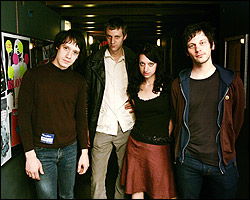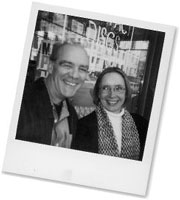REPUBLIC OF DREAMS, GREENWICH VILLAGE
by Ross Wetzsteon (Simon & Schuster, $35)
IN THE AGE of co-opting, grand-scale gentrification, and mass-marketed Pottery Barn aesthetics, the artist’s bohemia— a place where society’s norms are ceremoniously circumvented and where creative collaboration is not possible but probable—is as elusive as any idea of utopia, heaven, or even reasonable rent. Sure, places like Cuba, Prague, Chicago, and even Olympia are developing reputations as locations where one can create and live among others who are doing the same. Meanwhile, artists are in mass exile from cities like San Francisco where they can no longer afford to live, let alone create.
The absence of a contemporary creative nirvana, along with the fraying of Greenwich Village’s essential edge, is what makes Ross Wetzsteon’s Republic of Dreams, Greenwich Village: The American Bohemia, 1910-1950 so evocative and compelling. Wetzsteon’s portrait of the seminal square mile in New York City and the four decades that defined it suggests that its spirit and essence are singular. The artists and writers who crawled in from other cities and countries and found sanctuary in Greenwich Village established a community wherein they could teeter on the edge of insanity and greatness together. They were as diverse as their aesthetics and as eccentric as their art, and as a collective they formed a patchwork landscape of unified artistry unduplicated since.
Taken individually, the products generated by the Village denizens of this period are undeniably brilliant: feminist Emma Goldman’s radical politics, Willa Cather’s gender- and sexuality-challenging short stories, Jackson Pollack’s sometimes violent exhibits of abstract expressionism. The art and ideas born within the Village’s cobbled blocks, while themselves wildly inspirational and worthy starting points for other notable artists, are by-products of a community that was in and of itself a great work of genius.
WETZSTEON, a drama critic for the Village Voice who died shortly after completing 10 years of exhaustive work on this volume, outlines a cohesive set of dreams and dreamers, beginning with Mabel Dodge. A wealthy 30-year-old free spirit, Dodge—at the prompting of early investigative journalist Lincoln Steffens—organized evenings of revolutionary idea exchange. These meetings, dubbed Dangerous Characters Evenings, were forums for discussions on classless organization, artistic awakening, and social reform. Although she did little more than invite the right people, announce a topic (Sex Antagonism, Evening of Art and Unrest), lay out a lavish spread, and open her door, Dodge provided the setting for collaboration and creative exchange. It is that starting place—that meeting place—around which Wetzsteon reconstructs the lives of people like Dylan Thomas, e.e. cummings, Thomas Wolfe, and Delmore Schwartz. As Dangerous Characters, the individuals profiled here entered a veritable playground of inspiration and spawned some of the most significant developments in modern politics, art, and literature.
Through Wetzsteon’s expressive prose and great attention to lifestyle (marriages, affairs, and substance abuse are treated with great detail, yet Republic of Dreams never seems like a soap opera), a picture of the old Village as a meeting place of great minds emerges clearly but gently. This neighborhood biography delineates a world where the painter and the politician, the recluse and the revolutionary, lived side by side in a kind of symbiosis that was to be not often—perhaps never—repeated in history. The genius and beauty of this American bohemia is not individual accomplishment—not the leaps made in feminist thought nor the standards set by suffering poets—but the collective effort.
Wetzsteon illuminates but does not directly address the absence of that symbiotic society in our modern world. Can we create this kind of community ever again? Are such things generated willfully or do they occur only organically and without conscious structure? Who or what is responsible for the subsequent blandification of the Village and other formerly bohemian locales? Can we blame economics? Or Republicans? Or is the answer closer than we think?
In his introduction, Wetzsteon posits that the Village contributed to the greater artistic consciousness not just the work of its residents but the spirit of its dreams as well. He reminds us that the poet James Oppenheim approached this country thusly: “Is it dreamless? I bring it a dream!/ Lacks a vision? It shall have mine!” For those who are still dreamless and without vision, Wetzsteon’s rich portrayal is of a creative paradise that one day could, perhaps, again be found.








